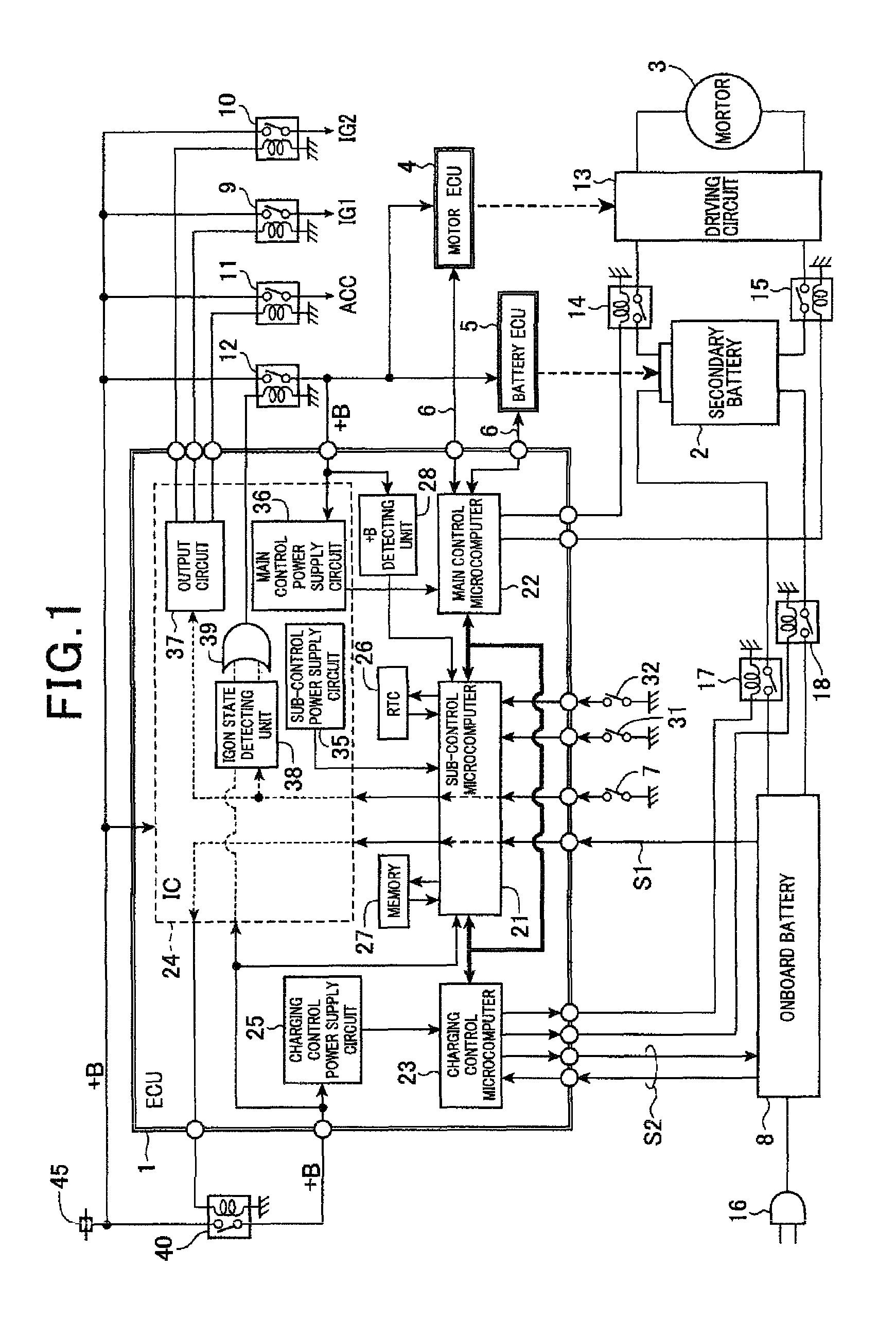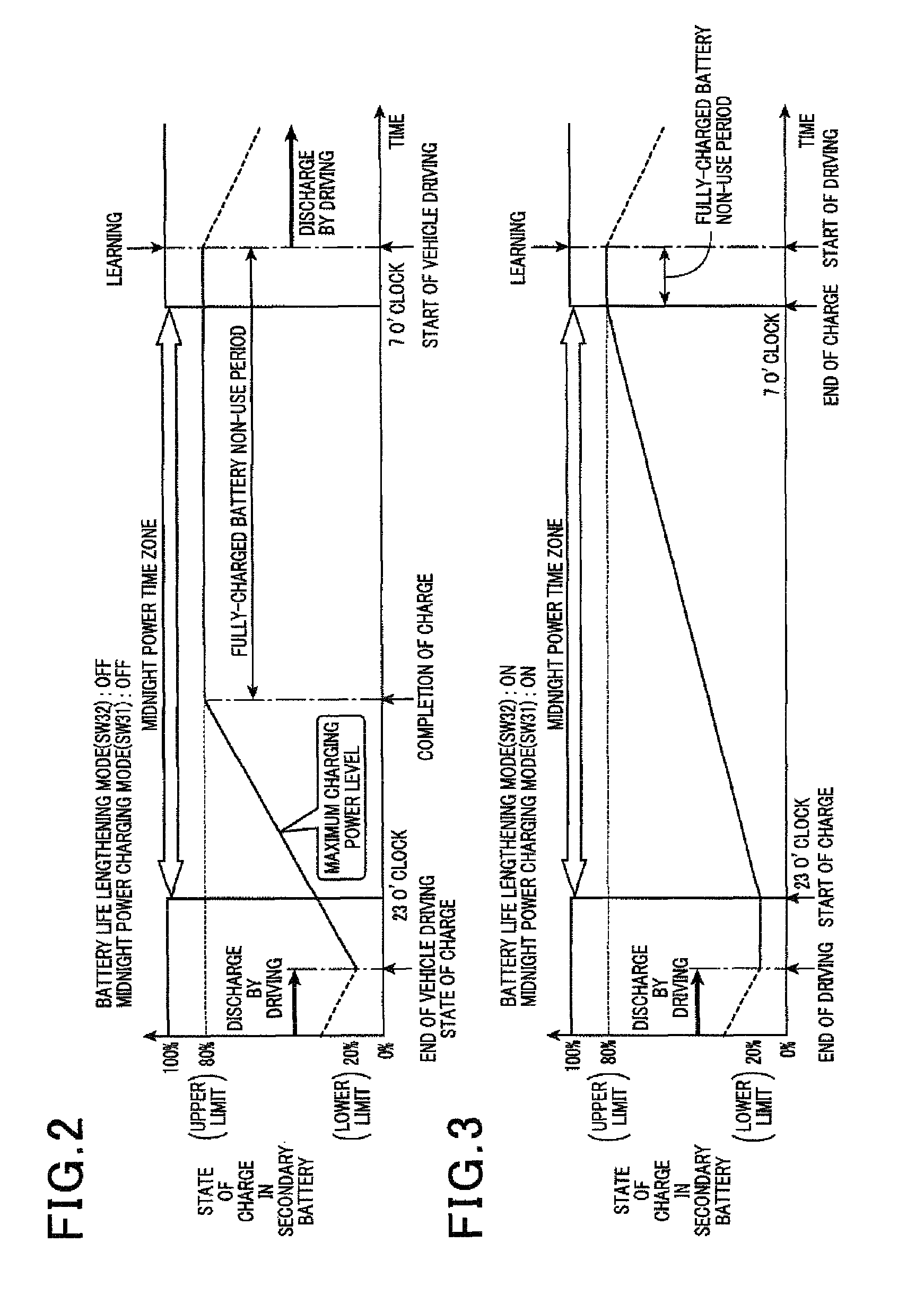Onboard charging control apparatus for controlling charge to secondary battery
a charging control and secondary battery technology, applied in battery/fuel cell control arrangement, hybrid vehicles, transportation and packaging, etc., can solve the problem of undesired shortened battery life and achieve the effect of reducing the electric rate of the charg
- Summary
- Abstract
- Description
- Claims
- Application Information
AI Technical Summary
Benefits of technology
Problems solved by technology
Method used
Image
Examples
first embodiment
[0032]An electronic control unit (ECU) acting as an onboard charging control apparatus will be described. FIG. 1 is a block diagram of the ECU 1 according to the first embodiment. This ECU 1 is mounted on a vehicle such as a plug-in hybrid vehicle. Further, an internal combustion engine (not shown) acting as a driving power source is mounted on this vehicle to provide running force to the vehicle.
[0033]As shown in FIG. 1, the vehicle is provided with a secondary battery 2 and an electric motor 3 driven by electric power of the battery 2. The motor 3 also provides running force to the vehicle. The battery 2 can be charged by an off-board power source (not shown) such as a power source for domestic use. This off-board power source is located outside the vehicle and applies an alternating current voltage of 100V or 200V, used on business at an office or the like.
[0034]An onboard battery 45 applies a battery voltage +B to the ECU 1, and the ECU 1 is operated. This ECU 1 has a function f...
second embodiment
[0189]FIG. 10 is a block diagram of an ECU 50 mounted on a vehicle according to the second embodiment. As shown in FIG. 10, the ECU 50 differs from the ECU 1 shown in FIG. 1 in that the ECU 50 has a sub-control microcomputer 51 in place of the microcomputer 21 and is not provided with the circuit 25 or the microcomputer 23. The ECU 50 controls an onboard charger 52 to charge off-board electricity to the secondary battery 2. The charger 52 is provided with a charging control power supply circuit and a charging control microcomputer 54.
[0190]The operation of the ECU 50 differing from the operation of the ECU 1 will be described. When the plug 16 of the charger 8 is inserted into a socket outlet of the off-board power source, off-board electricity is supplied to the charger 52, the charger 52 outputs a plug-in relay signal to the relay 40 in addition to a charging start signal S1 outputted to the microcomputer 51. In response to the plug-in relay signal, the relay 40 is turned on, elec...
third embodiment
[0194]FIG. 11 is a block diagram of an ECU 60 mounted on a vehicle according to the third embodiment. As shown in FIG. 11, the ECU 60 differs from the ECU 50 shown in FIG. 10 in that the ECU 60 has a well-known ignition switch (or a mechanical key) 61 in place of the switch 7, the detecting unit 38 and the circuit 37. The ignition switch 61 has a key receiving inlet. When the user inserts an ignition key into the inlet of the switch 61 and turns the key by one of predetermined angles, the relays 9 to 11 are set in the OFF state, the ACCON state or the IGON state. More specifically, when the key placed at the OFF position is turned to the ACC position, only the ACC relay 11 is turned on while the relays 9 and 10 are maintained to the OFF state together. When the key is turned to the IGON position though the ACC position, the relays 9 and 10 are turned on in addition to the relay 11 turned on. When the key placed at the ACC position or the IGON position is turned back to the OFF posit...
PUM
 Login to View More
Login to View More Abstract
Description
Claims
Application Information
 Login to View More
Login to View More - R&D
- Intellectual Property
- Life Sciences
- Materials
- Tech Scout
- Unparalleled Data Quality
- Higher Quality Content
- 60% Fewer Hallucinations
Browse by: Latest US Patents, China's latest patents, Technical Efficacy Thesaurus, Application Domain, Technology Topic, Popular Technical Reports.
© 2025 PatSnap. All rights reserved.Legal|Privacy policy|Modern Slavery Act Transparency Statement|Sitemap|About US| Contact US: help@patsnap.com



